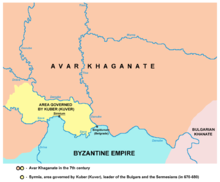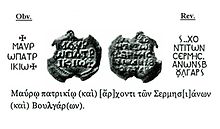Kuber
Kuber[3](alsoKouberorKuver) was aBulgarleader who, according to theMiracles of Saint Demetrius,liberated a mixed Bulgar andByzantine Christianpopulation in the 670s, whose ancestors had been transferred from theEastern Roman Empireto theSyrmiaregion inPannoniaby theAvars60 years earlier.[4][5]According to a scholarly theory, he was a son ofKubrat,brother of KhanAsparukhand member of theDuloclan.
Origins
[edit]According to the Byzantine scholar,Theophanes the Confessor,[6]Kubrat's (unnamed) fourth son, who left thePontic steppesafter his father's death around 642, became "the subject of the [Khagan] of theAvarsin Avar Pannonia and remained there with his army ".[7]According to a scholarly theory, first proposed by the Bulgarian historianVasil Zlatarski,Kuber was the fourth son ofKubrat,the Christian ruler of theOnogurBulgarsin the steppes north of theBlack Sea.[8][9]Kuber's story is continued in the second book of theMiracles of Saint Demetrius.[8][6]The book is a hagiographic work, written inThessalonikiin the 680s or 690s.[10][11]Denis Sinor wrote "The Avar Kaghan entrusted Kuber and his suite with the governing of the descendants of the Christian Byzantine prisoners of war, carried off sixty years ago, who were living mixed with Avars and Bulghars north of the Danube, not far from the former province of Pannonia Sirmiensis."[12]Nevertheless, Kuber's people soon liberated the POWs and led them south to the region of modernNorth Macedonia.The American historianJohn Van Antwerp Fine, Jr.writes that, if Zlatarski's theory is correct, Kuber was named for his father, because Kuber and Kubrat are most probably two Greek versions of the sameBulgarname.[13]However, others suggest Kuber is but a reference to Asparukh's ownKubiarbranch of Kubrat'sDulo clanwhere "Kubi-ar" may mean "fair haired".[14]Finally, Croatian researchers have proposed that Kubrat of Onoguria's five sons correspond to the five brothers fromWhite Croatiawho took Avaria in677,whereby Kuber would beChrobatos (Χρωβάτος).[15][16][17]
In Avar Pannonia
[edit]
Kuber was the ruler of a mixed population in theAvar Khaganate,including the descendants of the prisoners of war whom the Avars had captured in theBalkan Peninsulaand settled aroundSirmium.[8][6][18]He was made governor by the khagan.[11][19]Historian Samuel Szádeczky-Kardoss – who accepts Kuber's identification as Kubrat's son and thus a scion of the royalDuloclan – writes that Kuber became governor of that region, because the Khagan wanted to separate him from his Bulgar subjects who had followed him from the Pontic steppes.[8]Kuber's subjects called themselvesSermesianoi,[19]but the Byzantines regarded them "Bulgars".[20]They preserved their Christian traditions, although their ancestors had been taken to the Avar Khaganate about 60 years before Kuber's appointment.[6]
TheSermesianoidid not cease to dream of their return to their ancestors' homes.[6]Taking advantage of his subjects' feelings, Kuber rose up in open rebellion against the Khagan "in our times", according to theMiracles of Saint Demetrius.[21]Modern historians say that Kuber's rebellion occurred in the 670s or early 680s.[19][20][22]Around 70,000[23]Sermesianoijoined him and departed for theByzantine Empire.[11]The khagan attempted to hinder their migration, but they routed the Avars in five or six battles and crossed the riverDanube.[11]
In Byzantine Macedonia
[edit]

Kuber and his people moved as far as the region of Thessaloniki.[11][24]He decided to settle together with theSermesianoiin a plain and sent his envoy to the Byzantine Emperor, whom theMiracles of Saint Demetriosdid not name, to request his permission.[11]The emperor gave his consent and ordered the nearby Slavic tribe of theDragovitesto supply Kuber and his people with food.[11][19]However, Kuber's people still wanted to go back to their ancestral homes and started to disperse.[11]Fearing of the decline of his power base, Kuber asked the emperor to forbid theSermesianoito leave the plain and to confirm Kuber's position as their ruler.[11]His request seems to have been rejected, because he attempted to seize Thessaloniki, taking advantage of a civil war in the city.[11]However,Saint Demetriusunmasked Kuber's agents who tried to open the gates of Thessaloniki, hindering him from entering the city, according to the saint's hagiography.[11]
There is no more information of Kuber's life.[25]Some modern historians – including Zlatarski and Cankova-Petkova – say that he established a state in Macedonia which existed in parallel withKhan Asparukh'sBulgarian Empire.[26]They also write that the Byzantine EmperorJustinian IIwho had subjugated the Slavic tribes around Thessaloniki was ambushed and defeated by the Bulgars from Kuber's state on his return toConstantinoplein 689.[26][27]Asparukh's son,Tervel,cooperated with his "uncles in the region of Thessaloniki" against the Byzantine EmperorJustinian II,according to the inscription on theMadara Rider.[28][29]The Macedonian archaeologistIvan Mikulčić,who attributes the treasures found atVrapandErsekëto Kuber's people, says that archaeological findings confirm their presence inNorth Macedoniaand easternAlbania.[30]
Honour
[edit]Kuber PeakinTangra MountainsonLivingston Islandin theSouth Shetland Islands,Antarcticais named after Kuber.[31]
See also
[edit]References
[edit]- ^Balabanov, Kosta (2011).Vinica Fortress: mythology, religion and history written with clay.Skopje: Matica. pp. 273–309.
- ^"The Dating of the Vinic Terracots".Retrieved7 November2021.
- ^Conflict and Chaos in Eastern Europe, Dennis P. Hupchick, Palgrave Macmillan, 1995,ISBN0312121164,p. 138.
- ^Curta
- ^Fine
- ^abcdeFine 1991,p. 44.
- ^The Chronicle of Theophanes Confessor(357.13.), p. 498.
- ^abcdSzádeczky-Kardoss 1990,p. 215.
- ^Fine 1991,pp. 44, 46.
- ^Curta 2001,pp. 61–62.
- ^abcdefghijkFine 1991,p. 45.
- ^The Cambridge History of Early Inner Asia, Volume 1 p.215
- ^Fine 1991,pp. 44, 48.
- ^"Bulgarien 1300" Page 55 Peter M. Hill 1982
- ^Gluhak 1990,p. 222.
- ^Živković 2012,p. 111-122.
- ^Heršak & Nikšić 2007,p. 258.
- ^Szymański & Dąbrowska 1979,p. 59.
- ^abcdCurta 2006,p. 106.
- ^abHupchik 2002,p. 33.
- ^Fine 1991,pp. 45, 46–47.
- ^Fine 1991,pp. 46–48.
- ^Микулчиќ 1996,p. 71.
- ^Szádeczky-Kardoss 1990,p. 216.
- ^Fine 1991,pp. 45–46.
- ^abFine 1991,p. 72.
- ^Hupchik 2002,p. 35.
- ^Веселин Бешевлиев, "Първобългарски надписи", Издателство на Българската академия на науките, София, 1979, стр. 94 / "Protobulgarian inscriptions", Publishing house of theBulgarian Academy of Sciences,Sofia, 1979, p. 94
- ^[...] of Bulgars [...] and came to Tervel. My uncles in Thessaloniki region didn't credit to the slit-nosed Emperor (Justinian Rhinotmetus) and returned to Kisinas [...] his one [...] through treaty the ruler Tervel gave to the Emperor [...] five thousand [...] the Emperor together with me won well.
- ^Микулчиќ 1996,pp. 29–33.
- ^Kuber Peak.Archived2015-04-17 atarchive.todaySCARComposite Antarctic Gazetteer.
Sources
[edit]Primary sources
[edit]- The Chronicle of Theophanes Confessor: Byzantine and Near Eastern History, AD 284–813(Translated with Introduction and Commentary by Cyril Mango and Roger Scott with the assistance of Geoffrey Greatrex) (2006). Oxford University Press.ISBN978-0-19-822568-3.
Secondary sources
[edit]- Curta, Florin(2001).The Making of the Slavs: History and Archaeology of the Lower Danube Region, c. 500–700.Cambridge: Cambridge University Press.ISBN9781139428880.
- Curta, Florin(2006).Southeastern Europe in the Middle Ages, 500–1250.Cambridge: Cambridge University Press.
- Fine, John V. A. Jr.(1991) [1983].The Early Medieval Balkans: A Critical Survey from the Sixth to the Late Twelfth Century.Ann Arbor: University of Michigan Press.ISBN0-472-08149-7.
- Gluhak, Alemko (1990),Porijeklo imena Hrvat[Origin of the name Croat] (in Croatian), Zagreb, Čakovec: Alemko Gluhak
- Heršak, Emil; Nikšić, Boris (2007),"Hrvatska etnogeneza: pregled komponentnih etapa i interpretacija (s naglaskom na euroazijske/nomadske sadržaje)"[Croatian Ethnogenesis: A Review of Component Stages and Interpretations (with Emphasis on Eurasian/Nomadic Elements)],Migration and Ethnic Themes(in Croatian),23(3)
- Hupchik, Dennis P (2002).The Balkans. From Constantinople to Communism.Palgrave MacMillans.ISBN1-4039-6417-3.
- Микулчиќ, Иван (1996).Средновековни градови и тврдини во Македонија[Medieval towns and castles in the Republic of Macedonia].Makedonska akademija na naukite i umetnostite.ISBN9989-649-08-1.
- Szymański, Wojciech; Dąbrowska, Elżbieta (1979).Awarzy. Węgrzy[Avars. Hungarians].Ossolineum.ISBN83-04-00246-9.
- Szádeczky-Kardoss, Samuel (1990). "The Avars". In Sinor, Denis (ed.).The Cambridge History of Early Inner Asia (Volume I.Cambridge University Press. pp. 206–228.ISBN0-521-24304-1.
- Živković, Tibor(2012).De conversione Croatorum et Serborum: A Lost Source.Belgrade: The Institute of History.

